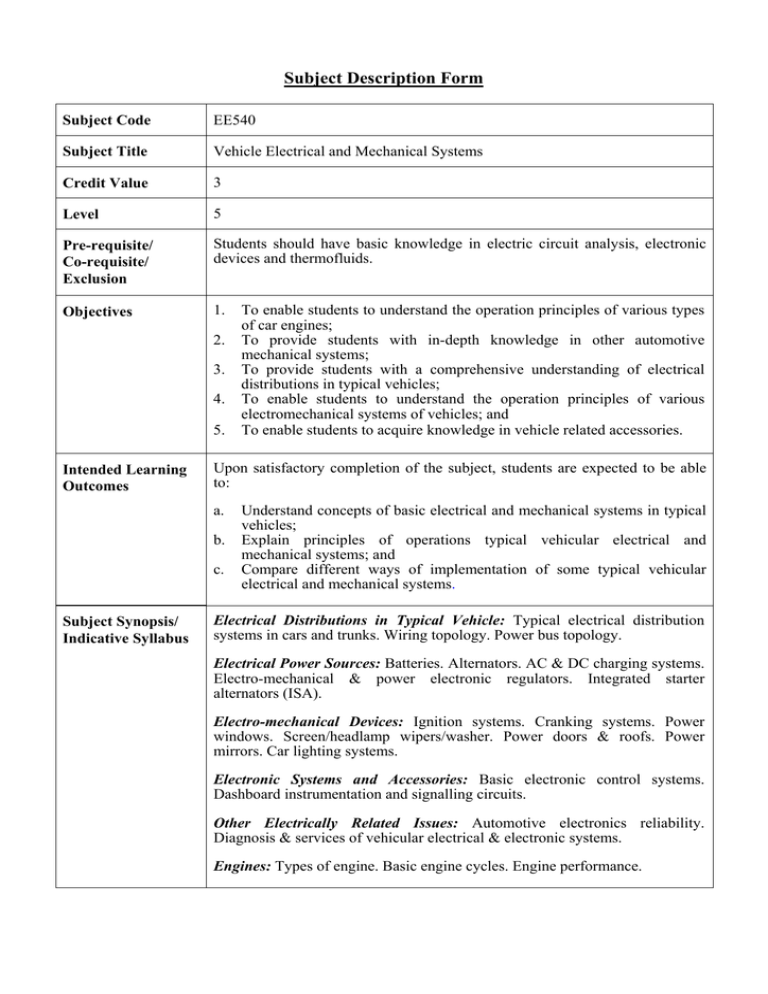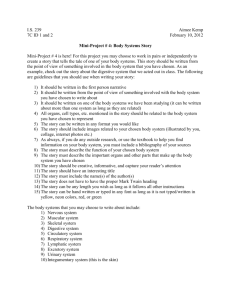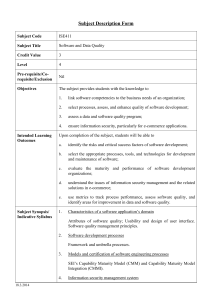
Subject Description Form
Subject Code
EE540
Subject Title
Vehicle Electrical and Mechanical Systems
Credit Value
3
Level
5
Pre-requisite/
Co-requisite/
Exclusion
Students should have basic knowledge in electric circuit analysis, electronic
devices and thermofluids.
Objectives
1.
2.
3.
4.
5.
Intended Learning
Outcomes
Upon satisfactory completion of the subject, students are expected to be able
to:
a.
b.
c.
Subject Synopsis/
Indicative Syllabus
To enable students to understand the operation principles of various types
of car engines;
To provide students with in-depth knowledge in other automotive
mechanical systems;
To provide students with a comprehensive understanding of electrical
distributions in typical vehicles;
To enable students to understand the operation principles of various
electromechanical systems of vehicles; and
To enable students to acquire knowledge in vehicle related accessories.
Understand concepts of basic electrical and mechanical systems in typical
vehicles;
Explain principles of operations typical vehicular electrical and
mechanical systems; and
Compare different ways of implementation of some typical vehicular
electrical and mechanical systems.
Electrical Distributions in Typical Vehicle: Typical electrical distribution
systems in cars and trunks. Wiring topology. Power bus topology.
Electrical Power Sources: Batteries. Alternators. AC & DC charging systems.
Electro-mechanical & power electronic regulators. Integrated starter
alternators (ISA).
Electro-mechanical Devices: Ignition systems. Cranking systems. Power
windows. Screen/headlamp wipers/washer. Power doors & roofs. Power
mirrors. Car lighting systems.
Electronic Systems and Accessories: Basic electronic control systems.
Dashboard instrumentation and signalling circuits.
Other Electrically Related Issues: Automotive electronics reliability.
Diagnosis & services of vehicular electrical & electronic systems.
Engines: Types of engine. Basic engine cycles. Engine performance.
Transmission and Driveline: Clutch. Gear box. Automatic transmission.
Continuously variable transmission. Matching between engine and gearbox.
Braking Systems: Braking system and components. Legal requirements of
braking system. Fundamentals of braking.
Air-conditioning Systems: Air-conditioning systems in cars.
Teaching/Learning
Methodology
Lectures and tutorials are effective teaching methods:
1. To provide an overview or outline of the subject contents;
2. To introduce new concepts and knowledge to the students;
3. To explain difficult ideas and concepts of the subject; and
4. To allow students to feedback on aspects related to their learning.
Mini-project works/assignments/presentations are essential ingredients of this
subject:
1. To supplement the lecturing materials;
2. To add real experience for the students;
3. To provide deeper understanding of the subject; and
4. To enable students to organize principles and challenge ideas.
Seminars from industrial experts may also be arranged, this will give student
up-to-date status of the development in alternative energy area, as well as
market trends.
Teaching/Learning Methodology
1.
2.
3.
3.
Assessment
Methods in
Alignment with
Intended Learning
Outcomes
Intended learning outcomes
a
b
c
√
√
√
√
√
√
√
Lectures
Tutorials
Case studies
Mini-project/Assignments/Presentations
Specific assessment
methods/tasks
1. Class tests
2. Mini-project/
Assignments/
Presentation
3. Examination
Total
%
weighting
20
20
60
100
Intended subject learning outcomes
to be assessed
a
c
d
Explanation of the appropriateness of the assessment methods in assessing the
intended learning outcomes:
1.
The assessment will comprise 40% continuous assessment and
60% examination.
2.
Student Study
Effort Required
The understanding on theoretical principles and practical considerations,
analytical skills and problem solving technique will be evaluated.
Examination, class tests, assignments, mini-project report and
presentations are an integrated approach to validly assess students’
performance with respect to the intended subject learning outcomes.
Class contact:
Lecture/Tutorial
Case study/Seminar
33 Hrs.
9 Hrs.
Other student study effort:
Self study
42 Hrs.
Mini-project/Assignments
21 Hrs.
Total student study effort
Reading List and
References
1.
2.
3.
4.
5.
6.
105 Hrs.
Halderman J.D., Diagnosis and Troubleshooting of Automotive,
Electrical, Electronic, and Computer Systems, Upper Saddle River, N.J.:
Pearson/Prentice Hall, latest edition.
Halderman J.D., Automotive Electricity and Electronics, Upper Saddle
River, N.J., Pearson/Prentice Hall, latest edition.
Denton T., Automobile Electrical and Electronic Systems, Oxford:
Elsevier Butterworth-Heinemann, latest edition.
Emadi A., Vehicular Electric Power Systems: Land, Sea, Air, and Space
Vehicles, New York; Basel: Marcel Dekker, latest edition.
Holt D.J., The 42-volt Electrical System, Society of Automotive Engineers
International, latest edition.
Happian-Smith J., An Introduction to Modern Vehicle Design,
Butterworth Heinemann, latest edition.


